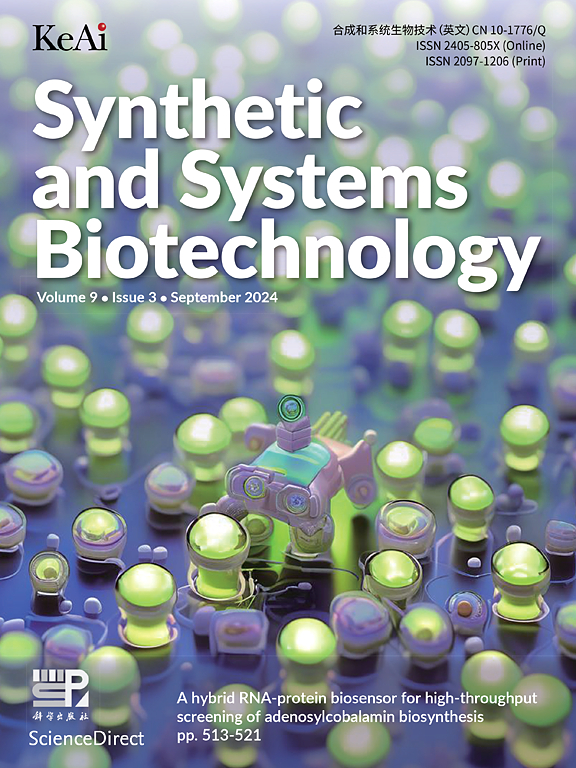Optimizing longifolene production in Yarrowia lipolytica via metabolic and protein engineering
IF 4.4
2区 生物学
Q1 BIOTECHNOLOGY & APPLIED MICROBIOLOGY
引用次数: 0
Abstract
Longifolene (C15H24) is a tricyclic sesquiterpene widely utilized in the cosmetics and fragrances due to its versatile applications. Traditional extraction methods from plants suffer from low titer and lengthy production cycles, while chemical synthesis is hampered by the compound's complex structure, leading to high costs and insufficient market supply. This study aimed to develop a microbial cell factory for enhanced longifolene production. The strategy involved integrating longifolene synthase from Pinus sylvestris (PsTPS) into Yarrowia lipolytica and employing multiple metabolic engineering approaches. Initially, key genes in the mevalonate (MVA) pathway were overexpressed to enhance longifolene precursor availability for longifolene biosynthesis. Subsequently, protein engineering techniques were applied to optimize PsTPS (tPsTPS) for improved catalytic efficiency. Furthermore, co-expression of molecular chaperones was implemented to enhance the synthesis and secretion of PsTPS. The introduction of the isopentenol utilization pathway (IUP) further augmented the supply of C5 substrate. By optimizing the culture conditions, including a reduction in culture temperature, the efflux of longifolene was increased, and the dissolved oxygen levels were enhanced to promote the growth of the strain. These collective efforts resulted culminated in the engineered strain Z03 achieving a noteworthy production level of 34.67 mg/L of longifolene in shake flasks. This study not only demonstrates the feasibility of enhancing sesquiterpene production in Y. lipolytica but also highlights the potential of microbial platforms in meeting industrial demands for complex natural products.

利用代谢和蛋白质工程优化多脂耶氏菌长叶烯的生产
长叶烯(C15H24)是一种用途广泛的三环倍半萜,广泛应用于化妆品和香料中。传统的植物提取方法存在效价低、生产周期长、化学合成受化合物结构复杂影响成本高、市场供应不足等问题。本研究旨在开发一种微生物细胞工厂,以提高长叶烯的产量。该策略包括将松长叶烯合成酶(pps)整合到多脂耶氏菌中,并采用多种代谢工程方法。最初,甲基戊酸(MVA)途径中的关键基因被过表达,以提高长叶烯前体在长叶烯生物合成中的有效性。随后,利用蛋白质工程技术对pps (tpps)进行优化,以提高其催化效率。此外,通过分子伴侣的共表达来促进pps的合成和分泌。异戊烯醇利用途径(IUP)的引入进一步增加了C5底物的供应。通过优化培养条件,降低培养温度,增加长叶烯的外排,提高溶解氧水平,促进菌株的生长。这些共同的努力最终使工程菌株Z03在摇瓶中获得了34.67 mg/L的长叶烯产量。本研究不仅证明了提高聚脂y菌倍半萜产量的可行性,而且强调了微生物平台在满足复杂天然产物工业需求方面的潜力。
本文章由计算机程序翻译,如有差异,请以英文原文为准。
求助全文
约1分钟内获得全文
求助全文
来源期刊

Synthetic and Systems Biotechnology
BIOTECHNOLOGY & APPLIED MICROBIOLOGY-
CiteScore
6.90
自引率
12.50%
发文量
90
审稿时长
67 days
期刊介绍:
Synthetic and Systems Biotechnology aims to promote the communication of original research in synthetic and systems biology, with strong emphasis on applications towards biotechnology. This journal is a quarterly peer-reviewed journal led by Editor-in-Chief Lixin Zhang. The journal publishes high-quality research; focusing on integrative approaches to enable the understanding and design of biological systems, and research to develop the application of systems and synthetic biology to natural systems. This journal will publish Articles, Short notes, Methods, Mini Reviews, Commentary and Conference reviews.
 求助内容:
求助内容: 应助结果提醒方式:
应助结果提醒方式:


